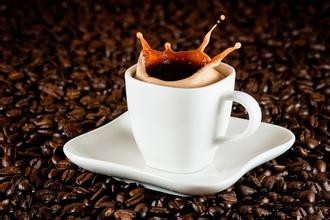Why is the dried coffee stain a ring instead of a solid circle?

Perhaps some of us have found this interesting phenomenon-coffee spilled from the cup often does not leave a solid round stain, but presents a ring mark along the edge of the coffee spill. Of course, no matter what shape the stains are, it won't make it harder for you to erase them.
Perhaps some of us have found this interesting phenomenon-coffee spilled from the cup often does not leave a solid round stain, but presents a ring mark along the edge of the coffee spill. Of course, no matter what shape the stains are, it won't make it harder for you to erase them. But when printing, this phenomenon is very annoying. The paint sample, which looks not bad, has changed beyond recognition after being killed. What are we going to do? It's a good thing we have physicists. Scientists at the University of Pennsylvania recently found that the way to prevent this is simple-you just need to change the shape of the particles involved.
Before a drop of water is dried, it is usually not reduced to a smaller drop of water, but flattened. Most children's shoes will observe that the water stains on the coffee table or bar will slowly change from a large drop to a small puddle, and then into a water film, and finally completely dry out. Because water molecules attract each other, they "fix" the surface of the liquid. This means that the water molecules will hold each other close to the surface of the liquid, while the water molecules in the milk will cling to the wall of the container. Because of this, different evaporation rates cause capillary seepage-the liquid at the edge evaporates, and the liquid inside will be replenished. The resulting inner-to-outward flow pushes almost all the liquid to the edge of the droplet, driving the pigment particles to move together. As it evaporates, dark ring marks are left on the outside and transparent in the middle.
Scientists at the University of Chicago first discovered the mechanism of the "coffee ring" effect, and then they observed that spherical particles were more likely to escape from the attraction of the liquid surface and move more easily from the middle of the liquid to the edge. On the other hand, ellipsoidal particles are more resistant to this capillary seepage, and they tend to leave a more flat and uniform imprint. If someone decides to produce coffee with ellipsoidal particles, we will be able to "appreciate" coffee stains of uniform color when we drink coffee. I saw the news from the university today, saying that it solved the problem of the coffee circle. The problem is that the coffee spilled on the table, when dry, forms a circle because the coffee particles gather to the edge in the process of losing moisture. The solution is simple: as long as the particles are lengthened, they will not gather, they will be evenly distributed on the changed surface, and the coffee circle will disappear, which is very useful for printing and paint development, the article was published in the journal Nature.
Important Notice :
前街咖啡 FrontStreet Coffee has moved to new addredd:
FrontStreet Coffee Address: 315,Donghua East Road,GuangZhou
Tel:020 38364473
- Prev

Books on coffee recommend the basics of coffee
Recently, in various forums and QQ groups, netizens have asked if they want to learn about coffee making and coffee culture. Are there any related books that can be recommended? Today, the editor has sorted out some professional books on coffee, which have been recommended for you for a long time, but they are several books worth reading for coffee lovers: recommendation one: coffee tasting Collection author: (Japan) Taguchi Nursing Publishing House: Liaoning Science
- Next

Needle to make espresso and cappuccino
Production time: 30 minutes difficulty: ★★☆☆☆ GEEK Index: ★★☆☆☆ needle can also make espresso Espresso! And very good ~ first weigh 10g coffee beans, the international standard Espresso is 7g beans, the Philharmonic pressure standard is 14g a cup of Espresso, we choose the middle value in between the two methods. Hand grinding. Grind back after grinding
Related
- Beginners will see the "Coffee pull flower" guide!
- What is the difference between ice blog purified milk and ordinary milk coffee?
- Why is the Philippines the largest producer of crops in Liberia?
- For coffee extraction, should the fine powder be retained?
- How does extracted espresso fill pressed powder? How much strength does it take to press the powder?
- How to make jasmine cold extract coffee? Is the jasmine + latte good?
- Will this little toy really make the coffee taste better? How does Lily Drip affect coffee extraction?
- Will the action of slapping the filter cup also affect coffee extraction?
- What's the difference between powder-to-water ratio and powder-to-liquid ratio?
- What is the Ethiopian local species? What does it have to do with Heirloom native species?

